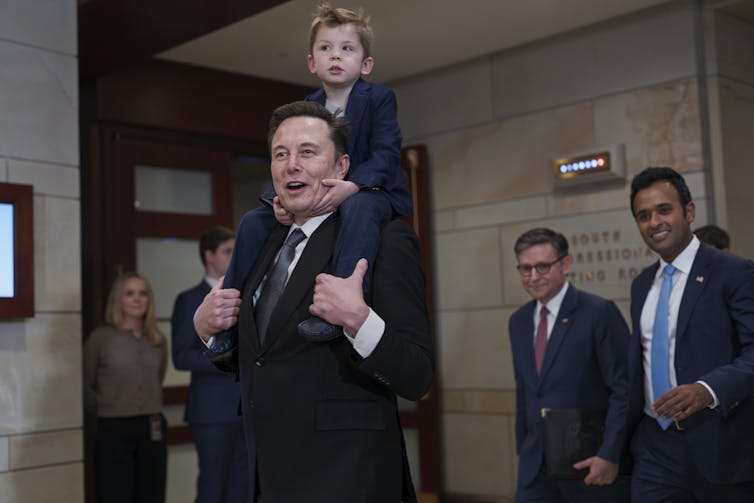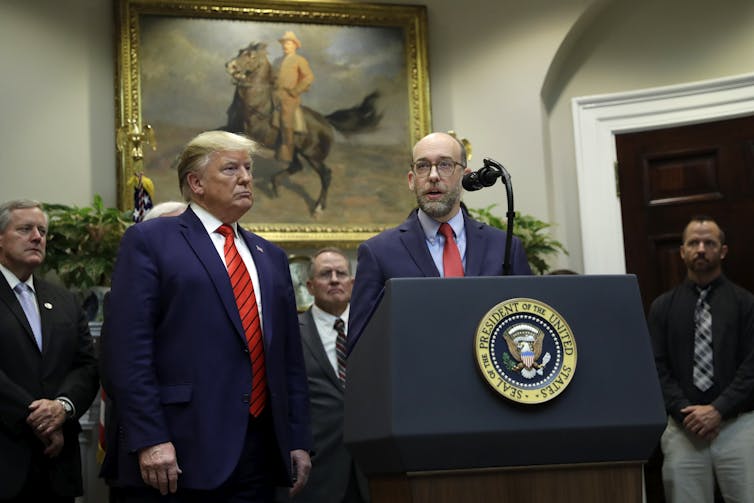
AP Photo/Andrew Harnik
Martha Coven, Princeton University and Bridget C.E. Dooling, The Ohio State University
The Office of Management and Budget sounds obscure, yet the agency plays a crucial role throughout the federal government. Presidents rely on the office to turn their ideas and wishes into actionable and funded policies.
To explain what the Office of Management and Budget does, the role of its director and the challenges it faces, The Conversation turned to Martha Coven and Bridget C.E. Dooling, who are experts on the federal budget and federal regulations and who both worked at OMB.
What does the Office of Management and Budget do?
The Office of Management and Budget, known as OMB, is a small but powerful agency housed within the Executive Office of the President. It is the central nervous system of the federal government, helping to implement the president’s vision for federal policy and operations while fulfilling its own legally mandated functions.
OMB’s responsibilities include:
-
Overseeing all budgetary matters, from preparing the president’s annual budget request to Congress to implementing spending laws passed by Congress. The office also coordinates what happens when the government shuts down after funding runs out. In other words, it stays on top of what it costs to run the federal government.
-
Coordinating and reviewing draft agency regulations, as well as aspects of how the government collects, analyzes and discloses information for statistical and other purposes.
-
Circulating virtually all draft executive orders and presidential memoranda to gather agency feedback.
-
Reviewing documents prepared by federal agencies before they go to Congress, including hearing testimony and proposals for new legislation and developing the formal administration position on draft legislation.
-
Overseeing management matters such as contracting, grants administration and information technology policy for all parts of the federal government. This work includes initiatives that cut across many agencies, such as the ongoing effort to improve the customer experience for government services.
OMB employs approximately 500 staff, nearly 90% of whom are civil servants. These are employees who are not tied to a particular presidency, who must be hired based on merit, and who do the day-to-day work of government.
What’s the role of its director?
The director of the Office of Management and Budget, which is a position that needs to be confirmed by the Senate, is unusual in serving both as a member of the president’s Cabinet and as a senior White House staffer. Most Cabinet secretaries spend relatively little time in the White House; their time is taken up running their agencies and traveling the country or even the globe.
The director, whose office is steps away from the White House in the Eisenhower Executive Office Building, is a regular presence in the West Wing, advising on a range of domestic, economic and national security matters, particularly from the perspective of how a decision might affect the federal budget, regulations or government operations.
At the same time, the director, who reports to the president, is responsible for running OMB as an agency and providing leadership to its staff. The director is also frequently in conversation with other agency heads and members of Congress.
The OMB director has two Senate-confirmed deputies, as well as several others in leadership positions to help run the agency. Some of these positions are Senate-confirmed as well.

AP Photo/J. Scott Applewhite
How important is OMB to an administration’s plans?
OMB plays a critical role because the agency uniquely possesses the combination of authority, expertise and intragovernmental relationships that are often necessary to turn significant policy changes into action.
For example, the reforms envisioned by President-elect Donald Trump’s Department of Government Efficiency – which is not a government department, despite its name – would typically require OMB’s budget, regulatory or management team’s involvement to move forward.
Proposals to cut federal programs ordinarily appear in the president’s budget, which OMB prepares for Congress every year. Proposals to eliminate or modify federal regulations must first be drafted and published by agencies in a process called rulemaking that OMB oversees. And OMB has experience with efforts to improve government efficiency – for example, in federal contracting. Indeed, the official statement from Trump announcing “DOGE” stated that the group “will partner with the White House and the Office of Management & Budget,” an acknowledgment of OMB’s central role in carrying out DOGE’s ambitions.
While OMB staff offer institutional memory, know-how and analytical skills to help advise any administration, the agency does not do its work alone. Much of OMB’s institutional strength comes from relationships with technical experts on every topic across the federal government who help identify potential problems and solutions.
In our view, White House and OMB leadership is at its best when it works closely with the agency’s staff to use federal agencies’ expertise. That way, it can ensure the president’s priorities are implemented effectively and efficiently.

AP Photo/Evan Vucci
What are OMB’s biggest challenges right now?
Coordinating the work of the US$6.8 trillion enterprise known as the U.S. government is not easy. Every administration has multiple power centers, which can make it difficult for the OMB director to ensure consistent application of the law and pursuit of presidential priorities across the federal government, despite the frequently competing interests of individual agencies.
The director is also frequently the person to say “no” to agency or White House staff ambitions, due to constraints on executive branch authority, how much money can be spent or whether there are the staff resources to carry out those ambitions.
In a second Trump administration, however, OMB leadership may be less focused on restraint and more on asserting unilateral presidential power. Trump plans to renominate former OMB Director Russell Vought, who is a driving force behind controversial ideas such as impounding federal funds rather than spending them as Congress directed. In addition, in the final months of Trump’s first term, Vought sought to make civil servants – including OMB’s own staff – easier to fire for inappropriate “temperament” or other factors, known as moving them to Schedule F status, which would strip civil servants of their job protections.
Vought’s second stint as OMB director, if he is confirmed, and if he picks up where he left off on impoundment and Schedule F, will be marked by tension with at least two core constituencies: members of Congress and civil servants.
The OMB director is also always in the middle of any discussion about fiscal policy, where a challenge will be the steadily rising national debt, which is on track to eclipse its World War II-era record as a share of gross domestic product.
Moreover, Congress and Trump are hoping to extend the large, expensive tax cuts passed during his first term and potentially expand them.
While OMB does not play a lead role in planning how the federal government raises the money to operate, the director will nonetheless have to defend to lawmakers and others any increases in the deficit and debt, unless Congress and the president can agree on substantial spending cuts or revenue increases.
This story is part of a series of profiles of Cabinet and high-level administration positions.![]()
Martha Coven, Visiting Lecturer in Princeton School of Public and International Affairs, Princeton University and Bridget C.E. Dooling, Assistant Professor of Law, The Ohio State University
This article is republished from The Conversation under a Creative Commons license. Read the original article.
























































